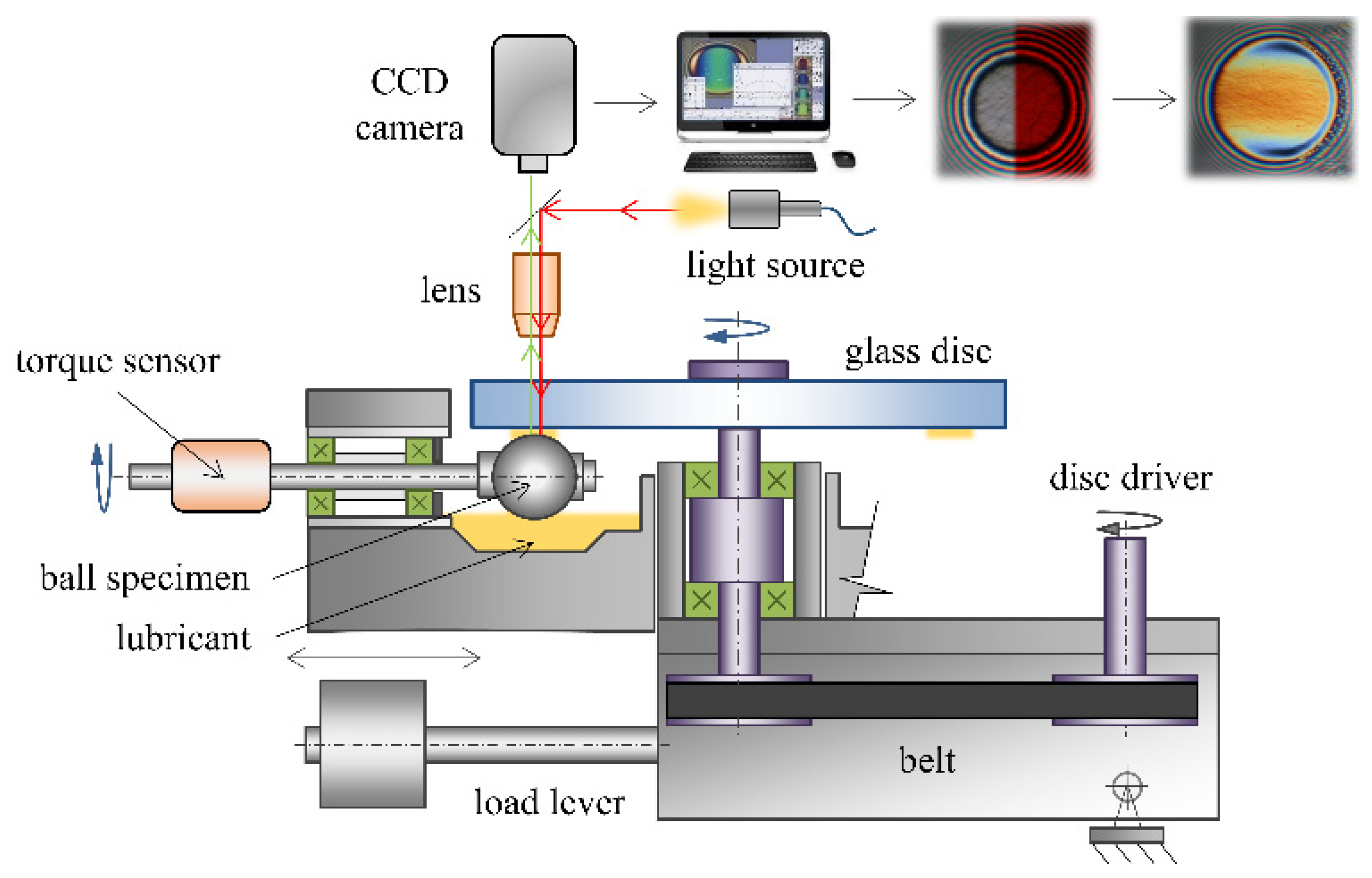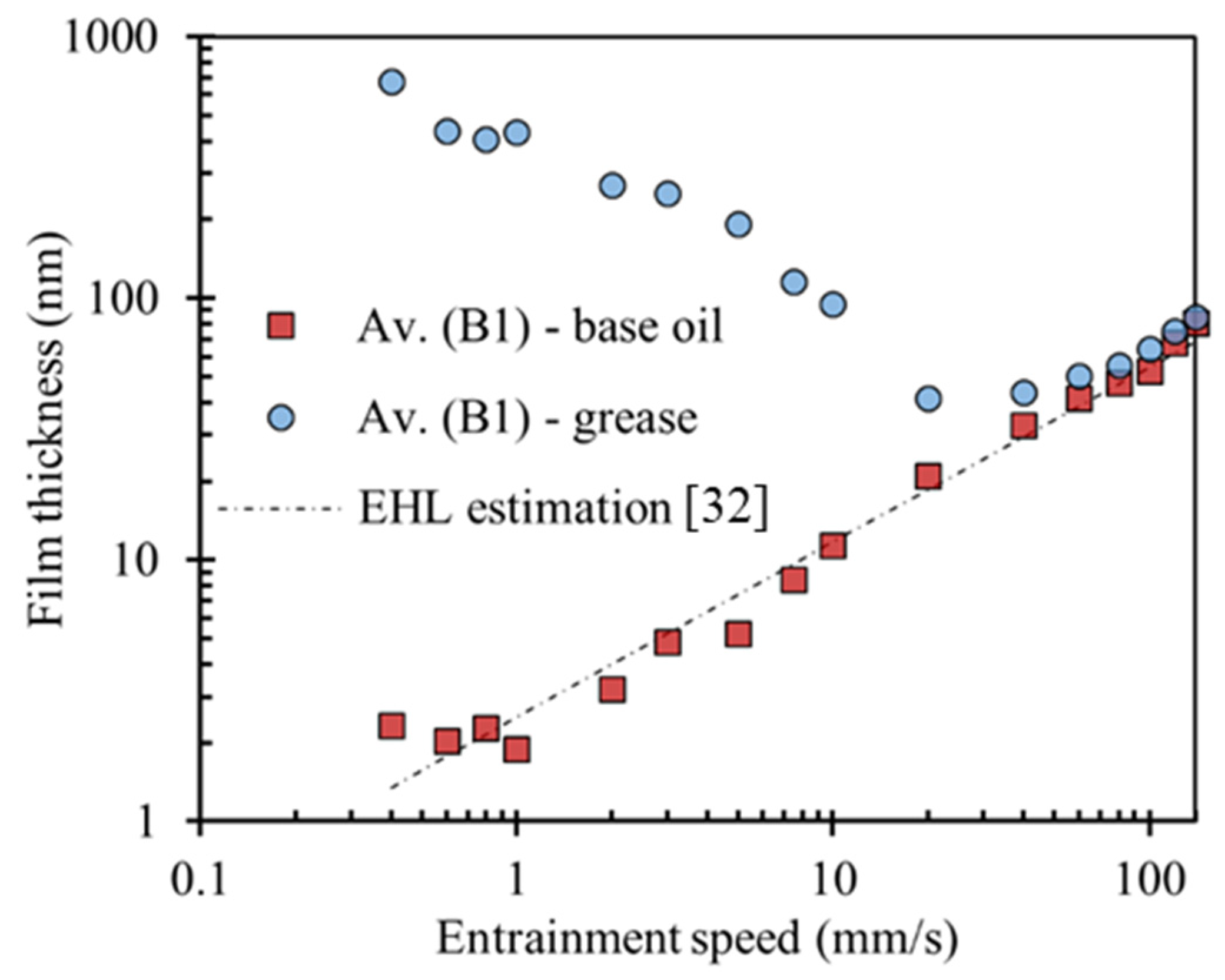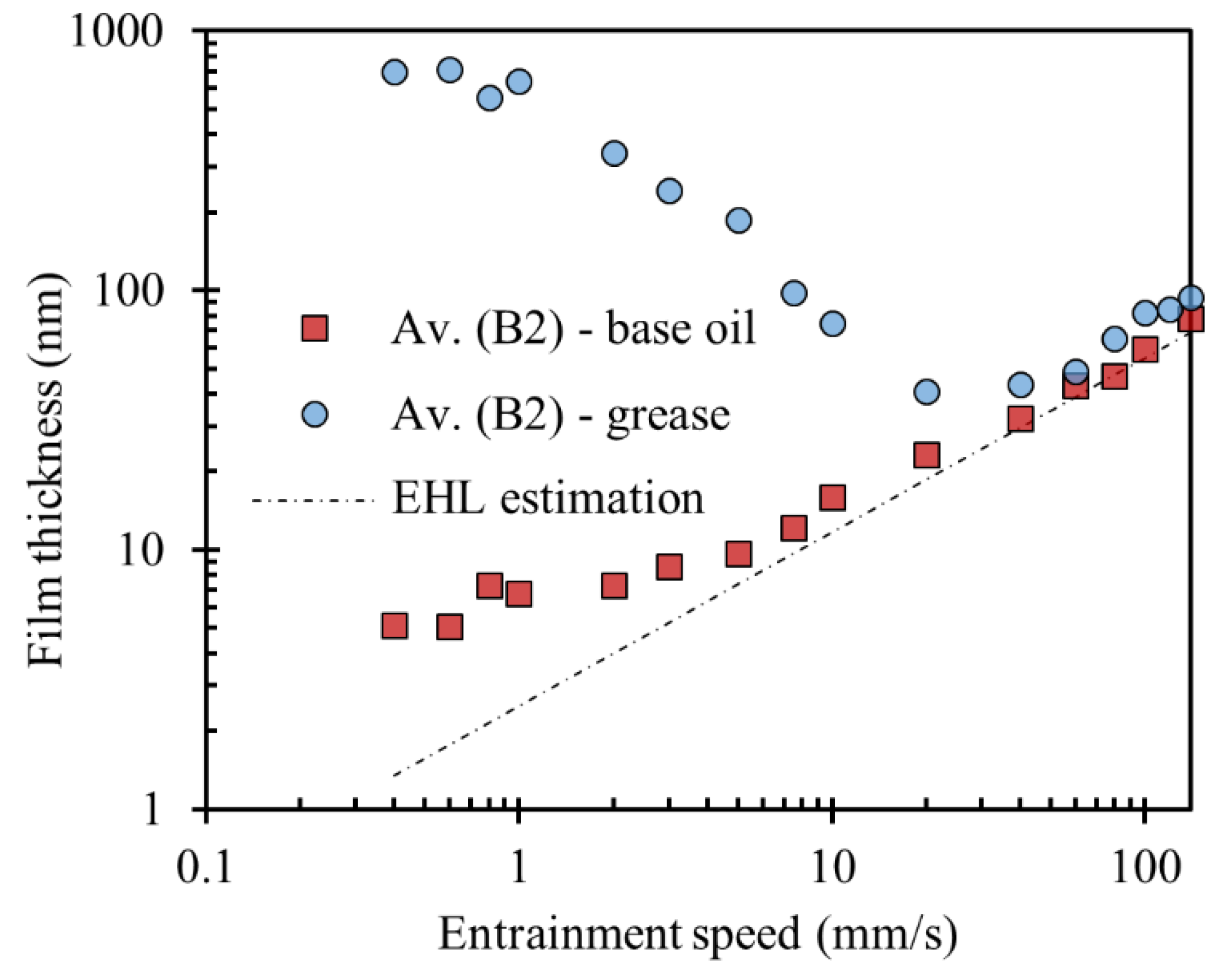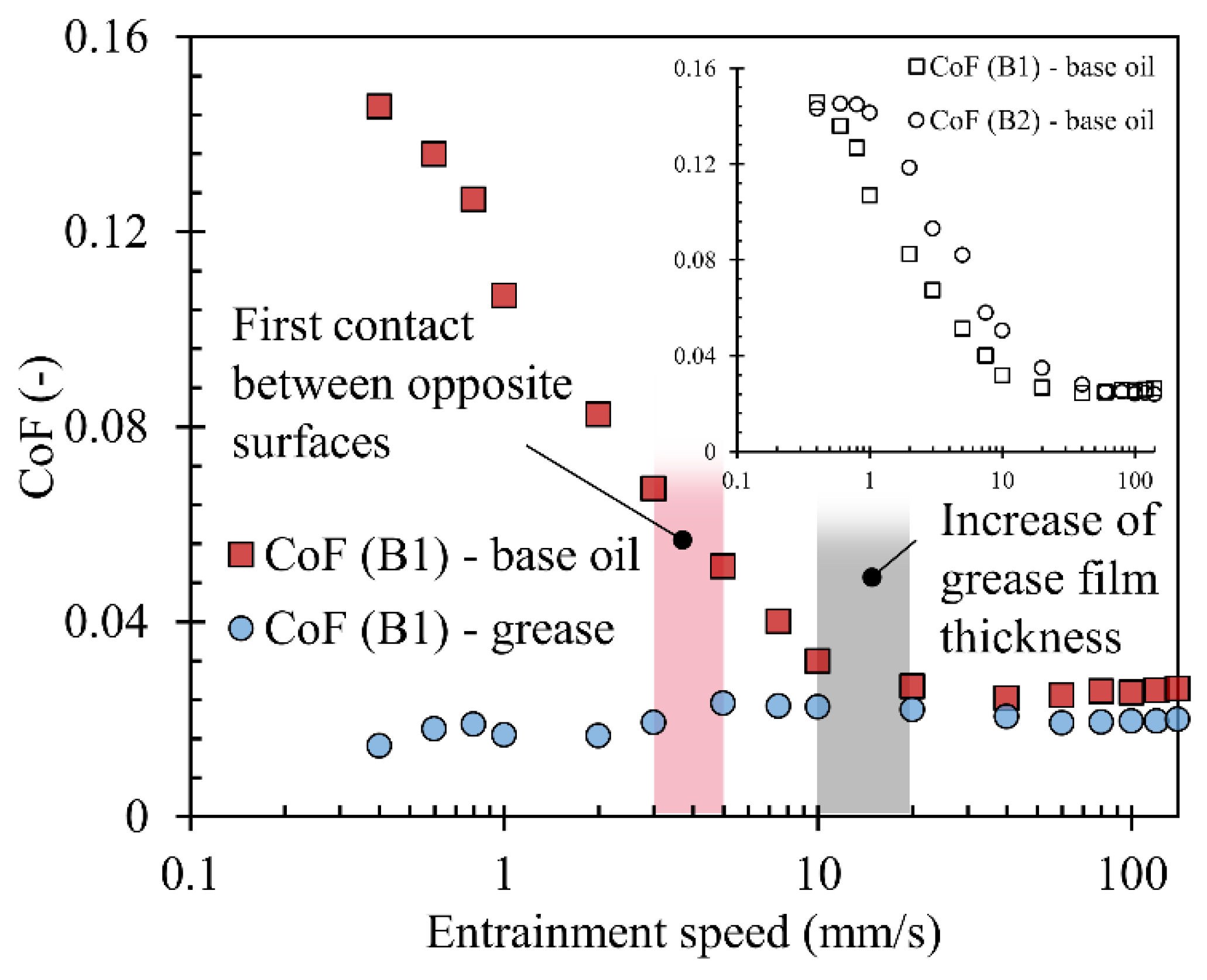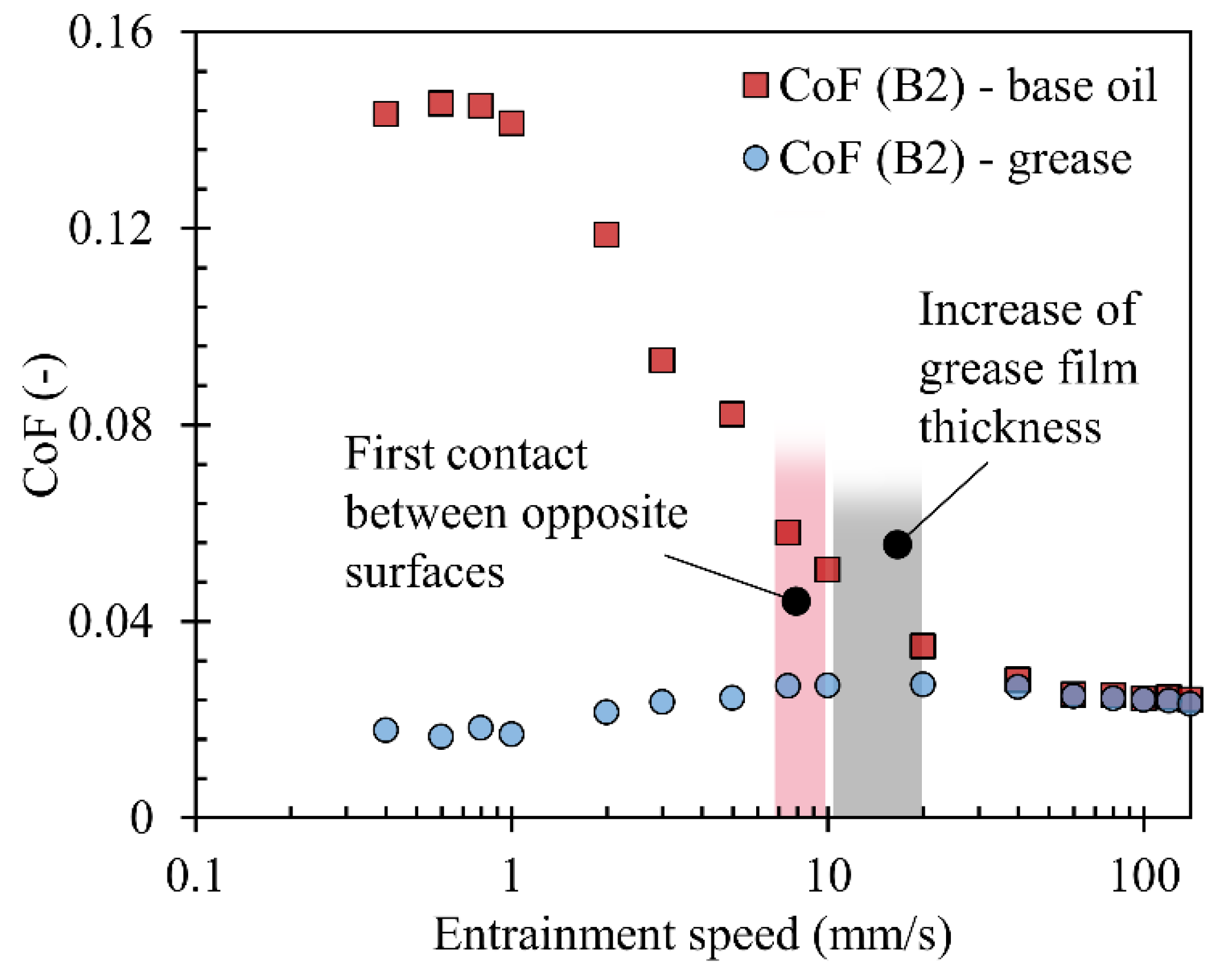1. Introduction
Grease is the most widely used lubricant in rolling element bearings. Over 90% of all rolling bearings are lubricated by grease [
1]. Grease is widely applied to rolling bearings because it ensures the separation of two surfaces and low friction. Therefore, it provides their long life. Grease is a multi-phase lubricant consisting of two main components, a base oil, and a thickener. This composition structure provides significant benefits. The biggest advantage of grease compared to base oil only is that it stays in place and it cannot easily leak out of a bearing because of its consistency. The complex structure of grease provides significant lubrication advantages compared to the base oils. On the other hand, the complex structure is the primary reason why the prediction of film formation and friction is so tricky. It is well known that the base oil and the thickener contribute to film formation in some way [
1]. Many studies focus on the film thickness and friction with the aim to obtain knowledge of grease behavior under different operating conditions.
Grease film thickness estimations are commonly grounded in its base oil or bleed oil properties. As it was shown in the previous studies [
2,
3], base oil or bleed oil film thickness developments are very close to grease at higher speeds under fully flooded conditions. The primary reason is that thickener does not enter the contact area. Thus, it seems valid to estimate the grease film thickness development using base oil or bleed oil properties at higher speeds. However, the precision strongly depends on the other properties such as viscosity improvers, additive package, and thickener type [
4,
5,
6,
7,
8].
A completely different film thickness development occurs for base oil, bleed oil, and grease at low speeds. The difference is most likely due to the thickener presence in the contact area [
1]. When the thickener reaches the contact area, its influence on the film thickness becomes dominant. The film thickness becomes much higher compared with base oil [
3,
7]. The dominant thickener behavior at low speeds was observed in the numerous previous studies [
7,
8,
9,
10,
11]. The thickener type, operating conditions, temperature, and base oil viscosity appear to be the most significant factors in the film formation process [
12,
13]. De Laurentis et al. [
3,
14] showed that the calcium sulphonate complex grease reaches almost the constant film thickness development with decreasing entrainment speed, while in the case of lithium and polyurea greases, the film thickness significantly increases. Morales-Espejel et al. [
15], Cen et al. [
16], and Gonçalves at al. [
7,
12] observed the same increase in the film thickness for lithium grease at very low speeds. They also showed that the increase in film thickness strongly depends on the temperature; with increasing temperature, the film thickness of grease deviates from the base oil at higher speeds. However, the main reason why the thickener enters the contact area at a lower speed remains not thoroughly clear.
A different grease film formation at low speeds also has an impact on the friction. A significant increase in friction (S-curve) can be observed when the speed decreases in the case of base oil [
17,
18]. In accordance with the mixed lubrication theory, the friction should increase due to the transition from the full film lubrication to the mixed lubrication regime; because of the first solid to solid contact at the surface asperity level [
19]. However, there are studies that indicate that the increase in friction could not be caused by direct solid to solid contact [
20,
21]. Numerous possible explanations for the friction increase before the contact can be found in the literature. The friction increase could be caused by the increase in lubricant viscosity due to the tapering gap between surfaces [
22,
23] or due to the pressure ripples caused by the entrance of surface asperities to the contact area [
24,
25]. Other possible explanations could be based on the change of molecules ordering in the lubricant [
26]; also due to the change of the lubricant flow in the contact area [
27,
28] or at the contact area inlet.
The previous studies that focus on a comparison of base oils or bleed oils and the grease friction showed that there is no significant S-curve for Li-soap grease [
14,
29]. De Laurentis et al. [
3,
14] showed that lithium and polyurea greases exhibit significantly lower friction than their bleed oils at lower speeds. At higher speeds, when the base oil properties become dominant, the base oil and the grease frictions are almost the same. At the point when the thickener starts to be dominant, the grease friction remains significantly reduced, even when the base oil friction increases.
The previous studies focused on fully flooded conditions clearly show that the grease and the base oil film thickness and friction are significantly different at very low speeds because of the thickener entering into a contact area. Recently, it was shown that friction increases much earlier before the first solid/solid contact between roughness features on Stribeck curve. Moreover, there is no deep understanding why thickener is entrained into the contact at low-speed conditions. This paper presents new data on film thickness and friction of grease and base oil in a transition from full to mixed lubrication. It seems that there can be a connection between the friction increase in base oil lubricated contact and the beginning of thickener entrance into the grease lubricated contact. It brings further insight into processes in elastohydrodynamically lubricated (EHL) contact at thin film conditions.
2. Materials and Methods
The experiments were conducted for two ball specimens with different surface roughness. The balls with 25.4 mm in diameter made of bearing steel AISI 52100 were modified by polishing using diamond pastes with different grain sizes. The root-mean-square (RMS) roughness values were measured at ten points all over the ball circumference using 3D optical profilometer; the variations are presented as standard deviations in
Table 1. The in-situ measurements were carried out on a ball-on-disc rig. The rig scheme is shown in
Figure 1. In this rig, the concentrated EHL contact is formed between a ball specimen and a flat transparent disc made of optical glass. The transparent disc allows an insight into the contact area and the film thickness distribution measurement. The rig uses a thin film colorimetric interferometry technique, which allows determining the film thickness distribution over the whole contact area; this technique is described in detail elsewhere [
30]. The glass disc is optically smooth with RMS = 0.5 nm. The ball and the disc are driven separately by servomotors to set different rolling-sliding conditions. The friction was measured simultaneously with the film thickness by a built-in torque sensor, which is mounted between the servo motor and the ball shaft.
The mineral base oil and the grease LV 2-3 were used in the current study. The grease is commercial grade lubricant with a Li-soap thickener and no EP additives; more details are provided in
Table 2. Regarding the base oil, the lubricant was transported to the contact area by dipping the ball in the lubricant reservoir, whereas the grease was applied to the bottom of the glass disc and artificially pushed back to the contact track by a specially designed rubber wiper with two rubber blades formed to the V-shape. The ball specimens and the disc were always cleaned from the rest of the lubricant and impurities using acetone before the following measurement. All the experiments were carried out under fully flooded conditions. The grease measurements were started when the lubricant was regularly distributed on the disc surface, which was achieved after several minutes of running.
The lubricant temperature was measured by a thermocouple as close to the inlet area as possible. All the experiments were carried out at 40 ± 0.5 °C. The film thickness and the friction were measured for the entrainment speed range from 0.4 to 140 mm/s and for two slide-to-roll ratios (SRR) +10% and −10%. SRR is defined as 2(ud − ub)/(ud + ub), where ud and ub are the disc and ball speeds respectively. The speed range was chosen to cover both full film and mixed lubrication regimes, especially the transition between them for both ball specimens. Each of the presented friction value was obtained by averaging from four values, two for positive and two for negative SRR ratios to prevent undesirable torque from supporting bearings. The load was maintained at 44.5 N corresponding to max Hertzian pressure of 0.6 GPa.
At first, the film thickness was evaluated from obtained interferograms using a custom-developed software called Achiles, which implements a thin film colorimetric interferometry measurement method [
31]. Next, the film thickness was exported as the matrix of values (typically 600 pixels × 600 pixels, where 1 pixel = 0.47 µm). After that, these matrixes were processed in MatLab software to obtain the average and the minimal film thickness for each entrainment speed. The average and the minimal film thickness were evaluated over the specific area, which corresponds to the 90% of Hertzian contact. The 90% of Hertzian contact was chosen to keep the evaluation process consistent and to be sure that the evaluation area is well inside the contact. Evaluated minimal film thickness value corresponds to the 0.5% minimal in a film thickness histogram over the evaluated contact area to prevent results from outliers. If the minimal film thickness reached a value below the film thickness resolution of the rig (0.2 nm), it was considered as direct solid to solid contact between opposite surfaces. All measured data were relative to a static interferogram, which was considered as a reference and concurrently used for the film thickness calibration. In the static contact, it was considered that complete load was carried by direct solid/solid interactions. A whole evaluation process is described in detail in the author’s previous study [
20].
3. Results and Discussion
The film thickness measurements were conducted for both lubricants listed in
Table 2. Each lubricant was measured for both B1 and B2 ball specimens to establish the effect of surface roughness.
Figure 2 and
Figure 3 show a comparison of the grease (blue dots) and the base oil (red squares) film thickness developments as functions of entrainment speed; both axes are in a log scale. The corresponding film thickness estimations based on the Hamrock–Dowson formula for EHL circular contact [
32] were included in each plot. The estimations were based on the base oil properties listed in
Table 2.
In the case of base oil, the film thickness corresponded fairly well with the estimations. A deflection occurred at low speeds around 1 mm/s for B1 and 7.5 mm/s for B2. The deflection was considered to be a consequence of a solid to solid contact. This was clear from the minimal film thickness shown in
Figure 4 for B1 and B2 specimens. The zero value was replaced by 0.01 because of the log-log scale in
Figure 4.
Further decreasing of speed seems to have no impact on the average film thickness, which tends to reach a finite film thickness value. The same film thickness behaviour and the finite film thicknesses were observed in the author’s previous study for other mineral base oil under the same kinematic conditions [
20]. The finite film thickness seems to depend on the surface roughness. Higher RMS roughness causes an earlier solid to solid contact, an earlier deflection from the power law, and higher finite film thickness. Small fluctuations in the film thickness at low speeds (
Figure 2 and
Figure 3) were caused by not entirely uniform surface structure around the ball circumference. The evaluation consistency was examined in the author’s previous study [
20]. It was found that standard deviations in film thickness were below 10%.
In the case of grease, a significant deflection from the linearity was also visible at low speeds. The deflection from the linearity occurred at higher speeds than in the case of base oil. There was a significant increase in the average film thickness for both ball specimens beginning around the entrainment speed of 20 mm/s, which corresponded with approximately 40 nm of the average film thickness. Such film thickness behaviour is typical for lithium grease, and it was observed in numerous previous studies [
14,
29]. A more detailed examination of interferograms revealed that the film thickness increased because of the thickener lumps in the contact area (
Figure 5). At the speed of 20 mm/s, the thickener lumps started to enter into the contact and locally increase the film thickness. It resulted in higher average film thickness. The observed deflection seemed to be the same for both ball specimens; it indicates that the film thickness was thick enough to have an effect on the thickener entering, so, surface roughness did not have a major influence on the thickener entraining into the contact.
Figure 5 clearly shows that the thickener did not enter the contact area above 20 mm/s. Therefore, the film thickness for the base oil and the grease were almost similar (see
Figure 1 and
Figure 2). The slight difference in film thickness at higher speeds could be attributed to the thickener, which increased the effective viscosity of the lubricant, which resulted in slightly higher film thickness. The thickener lumps in the contact area were visible below the entrainment speed of 20 mm/s (
Figure 5). With decreasing entrainment speed, the amount of thickener entering the contact area grew gradually. Therefore, the average film thickness increase was observed. Even when there was a significant increase in the average film thickness with decreasing entrainment speed, the places with no thickener persist (see the entrainment speeds of 5 mm/s and 1 mm/s in
Figure 5). Practically the same film thickness as for the base oil lubricated contact could be found in places where there were no thickener lumps. Therefore, the contact between opposite surfaces occurred in these areas at low speeds. The solid to solid contact could be seen from the minimal film thickness for the grease lubricated contact in
Figure 6, which was close to the minimal film thickness of the base oil lubricated contact (
Figure 4).
For B1 ball the initial contact was observed at the speed of 3 mm/s, even when the average film thickness was equal to 250 nm (
Figure 2). Even when the average film thickness seemed to be thick enough to separate surfaces the local contact between opposite surfaces might still occur. Representative solid to solid contact at low speed highlighted by white areas could be observed in
Figure 7.
Friction was measured simultaneously with the film thickness for both ball specimens.
Figure 8 and
Figure 9 present a comparison of the friction for the grease (blue squares) and the base oil (red squares) and both ball specimens. Each friction value was obtained as an average value of one-second running and an average from four measurements to obtain friction representative for a whole surface around the ball circumference. The comparisons show that the frictions for the base oil lubricated contact and both ball specimens were almost the same (
Figure 8 inset) at entrainment speeds above 40 mm/s. The friction of the grease also corresponded with the base oil at higher speeds quite well; this was because of the major influence of base oil properties as it was mentioned above. This can be seen in
Figure 5, where no thickener in the contact area was detected. The film thickness remained thick enough to suppress the effect of different surface roughness. The major differences in friction between the grease and the base oil lubricated contact occurred at speeds below 40 mm/s. The base oil friction rapidly increased, whereas the grease friction remained almost the same. In the case of grease, there was no significant friction increase. The thickener entrance to the contact area could explain such behavior (
Figure 5). It resulted in friction reduction, which remained very low. On the other hand, the base oil friction increased significantly for both ball specimens. The base oil friction exhibited an earlier increase, and it also reached higher friction values for B2 ball in comparison with a smoother B1 ball. According to the mixed lubrication theory, this steep increase in friction should be caused by the initial solid to solid contact between opposite surfaces [
18]. However, the minimal film thickness indicates that the contact occurred at lower speeds. This can be seen in
Figure 8 and
Figure 9, where the areas of the solid to solid contact between opposite surfaces are highlighted. The same phenomenon was observed in the author’s previous study for other mineral base oil [
20].
Based on the comparison of the film thickness and the friction, it is clear that the lumps of thickener entered into the contact area at the same entrainment speed as the friction of the base oil increased. As it was discussed in [
20], the increase in base oil friction is not due to the initial solid to solid contact. Therefore, it is possible that there could be the same explanation for two phenomena; the friction increases before the solid to solid contact and the thickener lumps entrance to the contact area.
As it was mentioned in [
20], three possible explanations for the friction increase before the solid to solid contact are suggested. It could be due to the pressure ripples related to the surface asperities deformed in a full film contact. Nevertheless, it should affect friction also at higher speeds, which has to result in higher friction for B2 than for smoother B1. However, friction levels are almost the same. It also does not explain the thickener entrance to the contact area. Other mentioned explanations such as the molecule ordering or the viscosity increase in nanoconfinement should have a significant effect in very thin films in a range of tenths or units of nanometers. In the current study, the thickener lumps start to enter the contact area when the average film thickness is still relatively thick around 40 nm. Therefore, this effect is unlikely the reason why the thickener enters the contact area. The third possible explanation is based on the change of the lubricant flow in thin films. It has been shown that the speeds profile may vary in thin films [
33]. The speed profile may change due to the tapering gap between opposite surfaces or due to the surface asperities, which may affect lubricant flow. Therefore, the change of the conditions or the lubricant flow at the inlet to the contact seems to be the most likely the explanation of why the thickener enters the contact area and why the base oil friction increases before the initial solid to solid contact.
